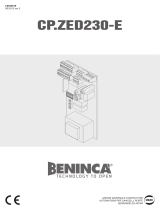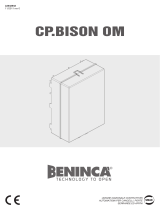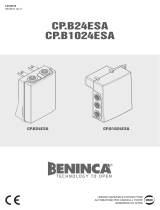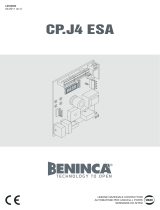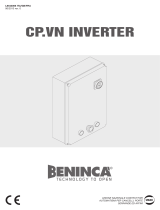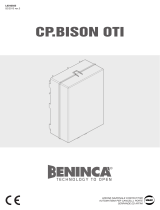Page is loading ...

L8542926
06/2011 rev 3
BE.TOUCH
UNIONE NAZIONALE COSTRUTTORI
AUTOMATISMI PER CANCELLI, PORTE
SERRANDE ED AFFINI

3
1
2
G
H
78mm
130mm
39mm
26mm
T
V

4
3
Y

10
EC Declaration of Conformity
The undersigned certifies that the product:
PROGRAMMABLE DIGITAL KEYPAD
BE.TOUCH
is compliant with all technical regulations re-
lated to a product within the application field of
EU directives 73/23/CEE,89/339/CEE and
ETSI EN 301 489-3 V1.4.1 (2002)
ETSI EN 301 489-1 V1.4.1 (2002)
ETSI EN 300 220-3 V1.1.1 (2000)
EN 60950-1 (2001)
All the necessary
radiofrequency tests have been performed
Manufacturer or authorised representative:
AUTOMATISMI BENINCÀ SpA
Via Capitello, 45 - 36066 - Sandrigo (VI) ITALIA
The manufacturer and, if applicable, the authorised
representative, are the only persons responsible for
this declaration.
Sandrigo, 10/04/2011
Benincà Luigi, Legal Officer.
FAST USER’S GUIDE
How to memorise a code (father)
• Activate the keypad by laying a hand on the screen.
• Type in the access password (123456 is the preset password)
• Press key 2 (2 beeps followed by an interval are heard)
• Digit the desired father code (1 to 9 digits), followed by Enter (3 beeps followed by
an interval are heard)
• Press one of the following keys, which identifies the coding type
1 Rolling-Code
2 ARC Advanced Rolling Code
3 Fixed Code
The device automatically emits two beeps and exits the programming mode.
Use
• Activate the keypad by laying a hand on the screen.
• Type in the previously memorised code, followed by Enter.
• Two beeps and two flashes of the back lights indicate the completion of transmis-
sion.
BE.TOUCH
Description
Programmable wireless digital keypad.
It allows to carry out the control of automatic
systems for gates and similar systems, with no
need to lay any cables.
BE.TOUCH is powered by two 3V batteries and
transmits the radiofrequency control to another
transmitter in a similar way.
The main characteristics are:
• A touch keypad of the capacitive type.
• LED retro light.
• Compatible with all Benincà radio receiver
models with 433.92 MHz operating frequen-
cy.
• Type of code: programmable code, rolling-
code and ARC (advanced rolling-code).
• 1 to 9 digit code composition.
• 0 to 9 keys plus ENTER to confirm.
• Possible setting of access password, scalar
code and elimination of single codes.
• Possible enabling of the ENTER key for code
repetition.
• Indication of down battery and buzzer for
acoustic indications.
• DL1 LED (Fig.1) switches on together with
the buzzer to facilitate the programming
phases.

11
TECHNICAL DATA
Power supply
Tao 3V lithium batteries (Li)
CR123A (1400mAh)
Range without obstacles 100m
Operating frequency 433,92 MHz
Operating temperature -20°C / +70°C
Number of storable codes 254
Protection level IP55
Overall dimensions see Fig.1
Wall installation (Fig. 2)
BE.TOUCH can be applied to wall through
washers and plugs supplied.
WARNING: As the various programming phases
require an access to the radio receiver of the
system, it is advisable to fix the keypad to wall
only after programming all functions.
The IP55 protection level permits to use the
keypad also on walls that are not protected
against weather agents. It is however advisable,
whenever possible, to apply the system on a
protected wall.
In any case, it is mandatory to apply the G
gasket between wall and container.
1 Open the container by loosening the screw
H.
2 Apply the bottom of the container to wall
by using either the two plugs T and the two
screws C, if a masonry support is provided,
or self-tapering screws, if a metal support of
provided: in any case, use a fixing suitable
to the support.
3 Close the container.
How to replace the batteries (Fig. 3)
Open the container by removing the screw H,
Fig.2.
A battery removable cover is supplied on the
rear part, fixed with the two screws Y, Figure
3.
Always replace both batteries with new batter-
ies CR123A, taking care of poles.
Duration of the batteries
The battery life always depends on the fre-
quency of use. The following table indicates
the indicative life of batteries according to
their use:
No. of activations/day * Foreseen battery life** (years)
0 6,5
2 6
5 5
10 4
*Activations of around 10 seconds
**Average temperature: 25°C
PROGRAMMING
Before proceeding to the programming of the
system, some aspects of the operating princi-
ples must be highlighted.
Before programming, carefully read all instruc-
tions.
Access password
The programming of the device is protected
by an access password which should be im-
mediately customized.
The factory-preset password is 123456.
Take note of the new password and keep
it in a safe place for future uses. If the
password is lost, the device will have to be
entirely reset, and all memorised codes will
be removed.
Father Code / Child Code
BE.TOUCH behaves substantially as a standard
radio transmitter. It sends the receiver a code
which is similar to the code that is sent by
pocket remote controls.
For an easier management of the system,
BE.TOUCH can store various digital codes
from the numeric keypad and match them to
one single radio code.
111111
222222
333333
444444
555555
9999999
In this example, the “Father” code 999999
is matc hed to various “Child” codes
(1111111/222222/etc.). In this way, new Child
codes can be included at any moment by acting
directly on BE.TOUCH, without having access
to the receiver.
In any case, the Father code must be stored in
the receiver memory.

12
The Father code operates independently from
the presence of related Child codes.
In the event of not particularly complex instal-
lations, it is possible to memorise Father codes
only, as indicated in Menu 2.
A specific radio code sent to the transmitter
corresponds to each Father code. This radio
code will occupy a memory location in the
receiver.
BE.TPUCH is able to store a total of 254 codes,
which might be either Father or Child codes.
IMPORTANT: Never use codes with too sim-
ple or easily traceable number sequence.
FUNCTION MENU
After activating the keypad, and typing the
access password followed by Enter, access
is enabled to the Function Menu (2 beeps are
heard from the buzzer).
BE.TOUCH awaits that one of the 9 Menu avail-
able is selected. During this dwell time, a beep
every 0.5sec is heard:
1 Change of access password for programming
menu
2 Typing in of Father code
3 Typing in of Child code
4 Erasing of Father/Child code
5 Activation of scalar counter
6 Configuration Menu of operation
7 Configuration Menu of proximity switch
8 Check Menu of the coding type of a memo-
rised transmitter code
9 Enable Menu of ENTER button for code rep-
etition.
Press the desired menu button.
NOTE:
• The keypad is activated by laying the hand
on the front side. The keypad will switch on
after a few seconds. In this way the duration
of batteries is maintained.
• Auto shut-off is 10 seconds. After this period
of time the system must be switched on
again, as described above.
• To exit a programming menu without mak-
ing any changes, press Enter, or wait for 20
seconds (time-out time).
• A possible programming error is indicated
with a long beep, BE.TOUCH then exits the
programming phase.
MENU 1
To customize the access password
After typing key 1, the customization of the
password phase is entered, indicated by 2
beeps followed by an interval.
- Type in the new password and press EN-
TER.
- BE.TOUCH confirms the typing with 3 beeps
followed by an interval.
- Type in the new password once more and
press ENTER.
- If the two digits are the same the password
is stored in memory and the keypad returns
to stand-by mode.
MENU 2
Typing in of Father code
After typing key 2, the customization of the
Father code is entered, indicated by 2 beeps
followed by an interval. The Father code can
be composed of 1 to 9 digits.
- Type in the desired Father code and press
ENTER. 3 beeps, followed by an interval, are
heard to confirm the operation. The device is
now waiting for a command which specifies
the type of receiver coding to be used for the
code just typed in:
- Press 1 for the Rolling-code receivers
- Press 2 for the ARC receivers
- Press 3 for the Fixed-code receivers
- Press ENTER to confirm selection, BE.TOUCH
exits the programming mode.
MENU 3
Typing in of Child code
After typing key 3, the customization of the
Father code is entered, indicated by 2 beeps
followed by an interval.
The Child code can be composed of 1 to 9
digits.
- Digit the Father code (followed by ENTER) to
which the Child code should be matched (it
will be typed in after). If the typed in Father
code is not valid, an error is shown. If the
code is valid, three beeps are heard and the
device awaits that the Child code be typed
in.
- Type the Child code and then press ENTER.
The code will be matched to the Father code
typed in before. The Child code will take the
coding type and the transmitted radio code
from the Father code.

13
MENU 4
Code erasing
After typing key 4, the erasing phase of the
code is entered, indicated by 2 beeps followed
by an interval.
- Type in the code to be erased and press
ENTER. Three beeps, followed by an interval,
confirm the operation.
If the erased code is a Father code, all corre-
sponding Child codes will be erased.
MENU 5
Specification of scalar counter
This function is not usable with Father codes.
After typing key 5, the specification of the
scalar counter is entered, indicated by 2 beeps
followed by an interval.
- Type in the Child code to which a scalar
counter should be matched. Then press
ENTER. If the code is actually present, three
beeps, followed by an interval are heard.
The following phase is entered in which the
counter value is specified.
- Digit a number between 1 and 999 and press
ENTER.
When new codes are typed in, the matched
counter is then decreased.
When the counter reaches zero, the matched
code is removed from memory.
MENU 6
Operation configuration
Through the Menu the following is possible:
- Activate or deactivate the buzzer.
- Switch the back light on and off.
- Activate or deactivate the auto switch-off.
The fabric configuration presets that all three
functions be activated.
After typing key 6, the password is required to
have access to advanced functions.
The password to have access to the advanced
functions is 654321 and it is not customiz-
able.
Press 6, two beeps are heard, press 654321,
three beeps are heard followed by an interval,
one of the following sequences are required
by the device:
- 1 (4 beeps) >1> (2 beeps)
if the acoustic indicator is to be activated
- 1 (4 beeps) >0> (2 beeps)
if the acoustic indicator is to be deactivated
- 2 (4 beeps) >1> (2 beeps)
if the back light is to be activated
- 2 (4 beeps) >0> (2 beeps)
if the back light is to be deactivated
- 3 (4 beeps) >1> (2 beeps)
if the “always lit-up” function is to be activated
- 3 (4 beeps) >0> (2 beeps)
if the “always lit-up” function is to be activated
*To be activated only if the device is powered
by an external source. The device is always
activated and does not require any button to
be pressed.
MENU 7
Operation as proximity switch
By activating this function, the keypad sends a
radio control also when the system is activated
(first touch).
This might be useful, for example, to activate
a courtesy light in the keypad area.
Around 2 seconds are needed for this function
at every activation of the device. During this
period of time it is not possible to type any
access codes.
After typing key 7, the function activation phase
is entered, indicated with 2 beeps followed by
an interval.
In the factory configuration this function is
disabled.
- Type in 1
if the function is to be activated
- Type in 0
if the function is to be deactivated.
If 1 is typed in, three beeps followed by an in-
terval are heard. The device awaits for the com-
mand to specify the coding type of the code
which will be transmitted when the BE.TOUCH
is activated.
- Type 1>(2 beeps)
if a Rolling-Code is desired.
- Type 2>(2 beeps)
if an Advanced rolling code (ARC) is desired.
- Type 3>(2 beeps)
if a Fixed Code is desired.
MENU 8
To check the coding type
If allows to check the type of radio coding re-
lated to a determined code stored in memory.
After typing key 8, two beeps followed by an

14
interval are heard. The system is waiting for
the code.
- Type the code to be checked followed by
ENTER.
If the code is memorised, BE.TOUCH replies
with 1, 2 or 3 beeps:
- Rolling-code: 1 beep
- Advanced rolling code (ARC): 2 beeps
- Fixed Code: 3 beeps
MENU 9
Code repetition activation with ENTER
Through this function it is possible to enable the
button, ENTER as code “repeater”, during the
20 seconds following the code introduction.
T h i s f u n c t i o n m i g h t b e u s e f u l t o
check t h e automat i c systems preset
with Step-by-Step cycle operation (e.g.
OPEN>STOP>CLOSE>STOP>OPEN>).
After 20 seconds, the system exits the repeti-
tion mode and a new valid code shall be typed
in again.
In the factory configuration this function is
disabled.
After typing key 9, two beeps followed by an
interval are heard. The system enters a wait
state.
- Type in 1
if the function is to be activated.
- Type in 0
if the function is to be deactivated.
Then, three beeps are heard followed by an
interval. The device activates or deactivates the
function and exits the programming mode.
TO MEMORISE THE FATHER CODES IN
THE RECEIVER
After programming the father/child codes as
required, the father codes must be stored in
the receiver memory.
Proceed according to instructions given with
the receiver.
When the receiver enter the wait state for a
code to be memorised, digit the FATEHR code
(or a Child code matched with it), press ENTER
and BE.TOUCH will send the code to be stored
in the receiver memory.
More than one receiver can be used, also
with a different decoding, and in the event of
multi-channel receivers, various codes can be
matched to various channels.
In the event of especially complex installations,
it is advisable to make and carefully keep a
diagram of the various receivers used, as well
as their functions and related BE.TOUCH codes
matched to it.
COMPLETE MEMORY RESET
1 Remove the batteries (if inserted) and wait
some seconds.
2 Now type in the memory reset password
“1234567890”.
3 An intermittent buzz can be heard to indicate
that the memory has been erased.
The reset restored the factory presetting. All
customized codes and settings are removed.
DISPOSAL
When the product is out of order, it must be
disposed according to regulations in force on
waste disposal and recycling of the various
components (metal, plastics, electrical wires,
etc.). For this purpose, it is advisable to contact
your installer or a specialised company.
/

